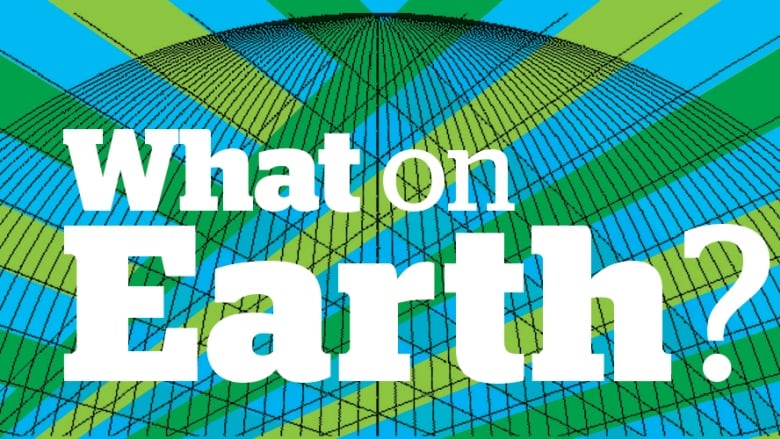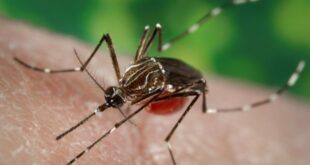Also: Another way to look at the 2023 Canadian wildfires.

Our planet is changing. So is our journalism. This weekly newsletter is part of a CBC News initiative entitled “Our Changing Planet” to show and explain the effects of climate change. Keep up with the latest news on our Climate and Environment page.
Sign up here to get this newsletter in your inbox every Thursday.
This week:
- Is plastic-free plastic even possible?
- Another way to look at the 2023 Canadian wildfires
- Ottawa using ‘creative accounting’ in 2-billion-tree pledge: environmental watchdog
Is plastic-free plastic even possible?

Earlier this year, I was shopping at my local Loblaws supermarket when a box of doughnuts caught my eye. It wasn’t the icing and rainbow sprinkles, beautifully displayed through what looked like a plastic window. Rather, it was the text in a black bubble in the corner of the window, which read: “This window is recyclable, repulpable and plastic-free.”
I wondered: Is this really plastic-free? And, if so, what’s it made of?
I bought the doughnuts and reached out to Loblaws to learn more. What I eventually found out is that the term “plastic-free” isn’t nearly as simple or self-explanatory as it sounds, and that making single-use packaging greener is a complex challenge for everyone involved.
It turns out that when these boxes hit the market, the window material was certified plastic-free by a London-based group called A Plastic Planet. Despite the certification, it has always technically been a bioplastic — that is, plastic made of biological materials like wood or food waste.
And apparently two years ago, A Plastic Planet stopped certifying bioplastic (or any other material, for that matter) as plastic-free. It doesn’t even consider bioplastic to be plastic-free anymore.
Confused? Then sit tight for a bit of a journey.
Loblaws’s baked goods used to be sold in disposable plastic boxes, as they still are in many other grocery stores. Unfortunately, these aren’t widely recyclable or recycled.
Loblaws said in an email that as part of its commitment to reducing plastic waste, it had partnered with Concord, Ont.-based Astro Box Corp. since 2021 to switch to paper boxes.
A note attached to the email from Laura Parlagreco, Astro Box’s vice-president of operations, said the window was made of cellulose acetate from wood pulp “sustainably sourced from fast-growing eucalyptus trees.”
I followed up with the president of Astro Box, Charles Parlagreco, who’s also a founding board member of the Paper and Paperboard Packaging Environmental Council.
He confirmed that both the box and window were fully recyclable as paper — in fact, any scraps of window and box left over from box-making are shredded together and sent to the company’s recycler, GFL, to be turned back into pulp (hence the term “repulpable”) and new paper products.
That might not be obvious to shoppers, so Loblaws included window recyclability info on the packaging, with help from Astro Box, which sourced the raw materials based partly on what eco-certifications (such as the plastic-free certification) those materials have, Parlagreco said.
He added that municipalities have different waste systems, and might deal with the window differently. (It’s certified as industrially compostable by the Biodegradable Products Institute, so some of them might be able to compost it, for example.)
When I reached out to the City of Toronto, it told me that the window, which it calls plastic, should be removed and put in the garbage, while the box should be put in the green bin if soiled and in the recycling bin if clean.
All in all, everything sounded rather complicated.
“It’s a very complex situation,” Parlagreco acknowledged, which is why the company relies on third-party certifications. “We use that to back up our statements to the customer.”
Wanting to learn more about the plastic-free certification, I reached out to A Plastic Planet. Sian Sutherland co-founded the group seven years ago with the goal to “turn off the plastic tap.”
She said A Plastic Planet launched the plastic-free certification four years ago “to really help the shopper understand when something … maybe looks and feels a bit like plastic, but when it is not a traditional fossil fuel plastic.” The certification included bioplastics that were already certified industrially compostable.
But two years ago, A Plastic Planet ended its entire certification program.
“We could see that we were actually becoming part of the problem and we weren’t helping people, particularly industry, get faster to the solutions,” Sutherland said.
Industrial composting hadn’t taken off as she thought it would. As a confusing array of bioplastics hit the market, A Plastic Planet raised its standards and no longer thought bioplastics met the bar for being “plastic-free.” The group worried that the certification could be used to greenwash products that didn’t break down into nutrients for nature.
The group gave customers a year to sell its remaining packaging bearing the plastic-free logo and certification.
When I shared this with Astro Box, the company was quite surprised. It said in an email that it has notified Loblaws about the plastic-free certification being outdated “and they are revising the statements made on the box as we speak.”
While A Plastic Planet has ended its certification program, other “plastic-free” certifications still exist — but what that means isn’t necessarily clear.
— Emily Chung
Old issues of What on Earth? are here. The CBC News climate page is here.
Check out our radio show and podcast. When the Scotty Creek Research Station in N.W.T. burnt down in an unusual late-season wildfire, it halted internationally recognized climate research. Now, the Liidlii Kue First Nation and a group of scientists are rebuilding it, looking at the unique opportunity to collect data before and after the fire. What On Earth airs on Sundays at 11 a.m. ET, 11:30 a.m. in Newfoundland and Labrador. Subscribe on your favourite podcast app or hear it on demand at CBC Listen.
Watch the CBC video series Planet Wonder featuring our colleague Johanna Wagstaffe here.
Reader feedback
In response to Zoe Yunker’s article about ecological corridors, M Hart wrote:
“It’s great to read about cities and provinces that are establishing these eco corridors as a refuge for wildlife and for city-dwellers to share and escape the heat … We all need to recognize how necessary they are and fight to protect them.”
Write us at whatonearth@cbc.ca.
Have a compelling personal story about climate change you want to share with CBC News? Pitch a First Person column here.
The Big Picture: Another way to look at the 2023 Canadian wildfires

Wildfires have defined the summer of 2023 in Canada. Not only did they start early in the season and send smoke wafting across the continent (and even over the Atlantic), but they have also covered more area than ever before.
How much area? According to federal data, roughly 13.4 million hectares (or 134,000 square kilometres). To put that in context — as the map above attempts to do — an area about the size of New Brunswick, Nova Scotia and Prince Edward Island combined has burned this summer.
Hot and bothered: Provocative ideas from around the web
-
The recent wildfires in Maui were the deadliest in the U.S. in more than a century. Why? Invasive species of grasses introduced to feed livestock had a big role to play, the New York Times reports.
- Young activists have won a landmark climate lawsuit in Montana. The judge agreed that a policy the state uses to evaluate requests for fossil fuel permits, which ignores greenhouse gas emissions, is unconstitutional.
-
Some farmers are going beyond free-range chicken and raising “tree-range” chicken instead — a form of regenerative farming that allows poultry to roam among trees and other perennial crops.
- Scientists say spreading volcanic rock dust on farmland has the potential to capture billions of tonnes of carbon dioxide. A new study has modelled just how much CO2 could be removed by this “enhanced weathering.”
Ottawa using ‘creative accounting’ in 2-billion-tree pledge: environmental watchdog

Canada’s environmental watchdog says Ottawa is using “creative accounting” to support the claim that its program to plant two billion trees is exceeding targets.
Jerry DeMarco, the commissioner of environmental and sustainable development, told CBC News that Natural Resources Canada (NRCAN) is using trees planted under a different program — and a different department — to boost its numbers.
“It’s creative accounting,” DeMarco told CBC. “It’s certainly within their prerogative to do that. But to achieve the benefits for climate, biodiversity and human health, adding trees is needed. Not simply finding trees and other programs that have already been planted and saying, ‘Oh, this now counts, we’ve got a higher number than anyone expected.'”
In August, Natural Resources Canada revised interim numbers on its progress toward the target of planting two billion trees by 2030-31.
By 2022, NRCAN was supposed to have planted 90 million trees. NRCAN says that, to date, it has planted approximately 110 million trees. The department initially said it had planted 29 million trees in 2021. It now says it planted 83 million trees that year.
The French-language website and newspaper Le Devoir first wrote about the change to the way the government reports the number of trees planted.
In a statement, NRCAN said it revised its 2021 figure by adding millions of trees planted through partner programs like Environment and Climate Change Canada’s Low Carbon Economy Fund (LCEF).
“Data from the LCEF program … was received and validated against the two-billion-tree program’s objectives this summer,” said Keean Nembhard, press secretary for Natural Resources Minister Jonathan Wilkinson.
In 2022, the department said it had planted 28 million trees through its partners, missing its interim target for that year of 60 million.
Conservative MP Greg McLean, who sits on the House of Commons environment committee, said the Liberals are being disingenuous with their math.
“Let’s admit to Canadians what this is. This program was a bit of a virtue signal in the first place,” McLean told CBC.
Wilkinson said in an interview with CBC’s Power and Politics that when the government announced its two-billion-trees initiative, it confirmed it would rely on other programs.
“I mean, at the end of the day, I am not sure Canadians care if some of the trees come from Low Carbon Economy or some come from other programs,” Wilkinson said.
He insisted what Canadians care about is the government achieving the aims behind its program — enhancing biodiversity and reducing greenhouse gas emissions.
But the environmental advocacy organization Nature Canada said that if the government is counting existing trees that were already planted, it cannot claim its two-billion-trees program is offering any additional value.
“This, to me, is very disappointing,” said David Wallis, Nature Canada’s reforestation policy and campaign manager. “It seems to indicate NRCAN is backing away from its commitment to plant two billion additional trees.
“They seem to realize they are not going to hit their target. Instead of coming clean to Canadians and fixing their program, they are choosing to deceive and make it look like they are planting more than they actually are.”
Ottawa is investing up to $3.2 billion over 10 years (2021-2031) in its tree-planting program.
The Government of Canada is planting only some of those trees. Ottawa relies on Indigenous communities, provinces, territories, businesses and non-profit organizations to do most of the planting.
The federal government provides half of the money required to plant trees through cost-sharing agreements.
The federal government has said it hopes provinces and territories will plant the lion’s share of the trees — 1.35 billion.
As of March, it had signed agreements with five of 10 provinces and two of three territories to meet the target.
— David Thurton
Stay in touch!
Are there issues you’d like us to cover? Questions you want answered? Do you just want to share a kind word? We’d love to hear from you. Email us at whatonearth@cbc.ca.
Editor: Andre Mayer | Logo design: Sködt McNalty
*****
Credit belongs to : www.cbc.ca
 Atin Ito First Filipino Community Newspaper in Ontario
Atin Ito First Filipino Community Newspaper in Ontario






